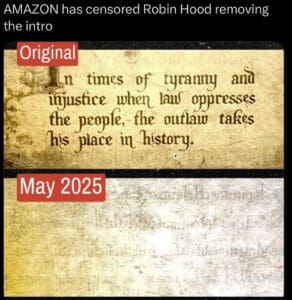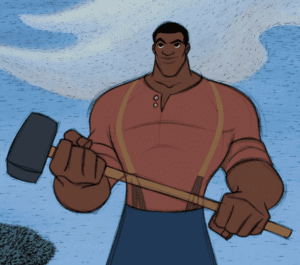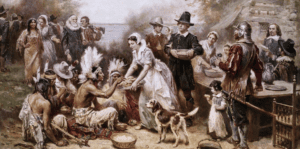Last night, before turning off my screens for the evening, I saw a meme circulating that, well, let’s just say, gave me pause. The meme claimed that a film version of Robin Hood streaming on Amazon Prime removed the opening text. “In times of tyranny and injustice when law oppresses the people, the outlaw takes his place in history.”

Looks like Amazon Prime, channeling its inner Prince John, may have decided that starting Robin Hood with that quote might hit a little too close to home. After all, who needs that kind of dangerous talk when you’re a trillion-dollar empire ruling the digital Sherwood Forest? Best to snip that bit out before viewers start getting funny ideas about resisting oppressive systems – or worse, questioning two-day shipping fees.
It could also be just as likely that Amazon is using an international “textless” version of Robin Hood, a common practice where any on-screen text (like opening quotes) is stripped out so that local broadcasters can easily add translations in their own language. Rather than anything sinister, this is probably just a case of logistical convenience, Amazon uploaded the easiest, most flexible version and didn’t bother to reinsert the original English text for streaming. In other words, it’s less a grand conspiracy and more a classic case of corporate laziness and cutting corners… maybe.
I say “maybe” because it wouldn’t be the first time Amazon has meddled in the affairs of a film’s narrative, or even real-world context. A few users on Reddit claimed that during the “Rust/Alec Baldwin” Controversy, Amazon’s streaming of the Royal Tenenbaums removed the entire intro by Baldwin and even edited out his narration. Beyond that (and far, far less subtle) in 2009, Amazon removed George Orwell’s 1984 and Animal Farm from users’ Kindles without warning. The irony of deleting 1984 (a novel about government surveillance and control) wasn’t lost on anyone, and the backlash was… notable, to say the absolute least. Amazon later explained that the books were uploaded by a third party without proper rights, but the incident sparked an ongoing debate about digital ownership and censorship.
Amazon has also quietly altered or restricted access to films and shows in certain regions and markets. They’ve removed or restricted LGBTQ+ content in countries where it would run afoul of local laws or norms, like the Middle East. In India, Amazon apologized and edited scenes from the show Tandav after political backlash, removing content deemed offensive by certain religious and political groups. This may be deemed “understandable” by the masses, and far less “worrisome” than most. We never want to offend, after all.
HOWEVER, if Amazon intentionally removed the Robin Hood quote, in true oligarch style, Amazon isn’t just streaming content; it’s safeguarding the status quo. Sure, Robin Hood can still fire arrows and swing from trees, but let’s not overdo the whole “fight the rich and redistribute the wealth” thing. Keep it light, keep it fun, and whatever you do, don’t remind the peasants – er, customers- that outlaws sometimes become heroes. Wouldn’t want the villagers organizing in the comments section, now, would we?
WHY is Robin Hood?
I can’t help but wonder though, is there currently a person, or persons who may fit the Robin Hood role in America? Or, to an oppressive regime’s fears, would that quote be inspiring? The film itself wasn’t removed, just the quote. The quote, though, IS context, the simplest, broadest terms. WHY is Robin Hood? The quote explains the WHY.
Luigi Mangione has entered the chat. Luigi is the suspect in the high-profile murder case of UnitedHealthcare’s CEO, around whom a surprising wave of public sympathy and fundraising has emerged. Many, many supporters view him (rightly or wrongly) as a symbolic figure of resistance against perceived injustices in the healthcare system.
 Luigi taps into a broader cultural narrative we often see when corporate power is perceived as oppressive or exploitative. He’s becoming a potential folk hero right before our eyes. There’s a groundswell of public sympathy and fundraising support for Luigi, not necessarily because people condone violence, but because many view him symbolically as someone who fought back against a system seen as unjust. UnitedHealthcare, as a massive health insurance company, has faced criticism over the years for denying claims, prioritizing profits over patients, and contributing to systemic issues in healthcare access. In that climate of frustration and anger, Luigi rises. The fact that people are rallying around him reflects a sentiment that legal guilt and moral judgment are not always aligned when the system itself is viewed as corrupt or tyrannical.
Luigi taps into a broader cultural narrative we often see when corporate power is perceived as oppressive or exploitative. He’s becoming a potential folk hero right before our eyes. There’s a groundswell of public sympathy and fundraising support for Luigi, not necessarily because people condone violence, but because many view him symbolically as someone who fought back against a system seen as unjust. UnitedHealthcare, as a massive health insurance company, has faced criticism over the years for denying claims, prioritizing profits over patients, and contributing to systemic issues in healthcare access. In that climate of frustration and anger, Luigi rises. The fact that people are rallying around him reflects a sentiment that legal guilt and moral judgment are not always aligned when the system itself is viewed as corrupt or tyrannical.
Folklore Tells Us About Ourselves
For as long as tall tales have shaped American identity, folklore figures like Paul Bunyan, Johnny Appleseed, and Davy Crockett have been paraded as the ultimate symbols of rugged individualism, expansionist zeal, and good old Manifest Destiny- traits celebrated as the backbone of the nation, and, in more recent times, possibly co-opted by toxic masculine influencers and “individualism” without understanding the context. These mythic men were heavily commercialized in the 19th and early 20th centuries to promote a shiny vision of westward expansion and American exceptionalism, all while neatly sweeping aside those awkward details like Indigenous genocide, environmental destruction, and, well, reality. It’s folklore with a generous side of whitewash- literally. Paved right over it all like a parking lot.
But lurking just off the mainstream stage is John Henry, one of America’s true folk legends and original badasses- a steel-driving man who faced down a steam drill in a battle of man versus machine, won gloriously, and promptly dropped dead from the effort. His story is all muscle and grit: a giant of a man hammering steel rails through mountains faster than any soulless machine could manage. Born from the brutal, backbreaking labor of post-Civil War railroad work, John Henry became a symbol of human strength, dignity, and the crushing toll of “progress” – a potent reminder that even the strongest among us can’t outrun the march of industrialization.
So why hasn’t John Henry enjoyed the same pop culture glow-up as Bunyan or, say, Captain America? Sure, part of it is that his story is a downer (we love a scrappy underdog) but preferably one who survives to fight another day. But there’s a bigger reason, too: John Henry’s legend is inseparable from African American history and labor struggles, themes that mainstream mythmaking has long preferred to sideline in favor of tidier, more marketable narratives. It’s a lot easier to sell action figures of a happy-go-lucky lumberjack with a giant blue ox than a heroic Black worker who dies challenging systemic oppression and mechanized exploitation.

And yet, John Henry’s story feels more urgent than ever in today’s world of AI anxiety and gig economy burnout. He should, by all accounts, the folkloric poster boy for the Millennial experience. His whole story is about grinding yourself to the bone to prove your worth only to find out the system was rigged all along. Millennials know that hustle all too well: the promise that hard work leads to success, only to face crushing student debt, skyrocketing housing costs, and job precarity. Like John Henry swinging that hammer, millennials have been told to outwork the machines (or algorithms, or economic forces), but many are realizing that no matter how hard you grind, the system is built to exhaust you.
John Henry’s battle was literally against automation and the devaluation of human labor, which couldn’t be more relevant today. Millennials, and to an extent, Gen Z, came of age during the rise of automation, AI, and now gig work, constantly adapting to new technologies that promise “efficiency” but often erode job security and mental health. John Henry’s struggle feels like a folk-tale version of what happens when you’re told to compete with machines, and his tragic end captures the burnout and disillusionment that so many millennials experience. In a world of overwork and under-reward, John Henry is basically the original millennial icon, right alongside Kiki herself (watch or read Kiki’s Delivery Service, you’ll understand).
Right on the heels of John Henry (and Kiki) stands the often-overlooked Sally Ann Thunder Ann Whirlwind Crockett- one hell of a freaking awesome name. Also… who? Sally is one of American folklore’s wildest tall tale heroines. Introduced in the 19th-century Davy Crockett Almanacs, she’s portrayed as Davy’s wife, but her legend stands on its own; she’s a frontier woman of epic proportions, said to have been born during a thunderstorm (like dragon) and raised on a steady diet of alligators and wildcats.
Her adventures are gloriously over-the-top: wrestling grizzly bears, tying lightning bolts into bows, and out-fighting and out-talking any man around. The original American “girlboss”, she’s the embodiment of frontier toughness, blending raw strength with a sharp wit and a rebellious streak. Sally Ann flips the script on the typically male-dominated tall tale tradition, proving women could be just as bold and untamable as the men. While she never achieved the mainstream fame of figures like Paul Bunyan or Johnny Appleseed, likely because a powerful, independent woman didn’t fit the tidy mold of American mythmaking, something we’ll revisit again shortly.
A Growing American Trend?
Controlling a folkloric narrative is nothing new, and censoring a story certain isn’t. A more insidious form of folklore control has been the systematic sidelining of marginalized groups’ folklore in mainstream culture and education. For example, African American folklore, such as Br’er Rabbit tales or slave spirituals, was often appropriated and stripped of its context of resistance and survival. Native American oral traditions were often rewritten or filtered through a Euro-American lens that romanticized or misrepresented them. Until relatively recently, public folklore programs and school curricula emphasized European-American tales while minimizing the folklore of immigrants, Indigenous peoples, and communities of color.
Even within the last decade debates over Confederate monuments, Thanksgiving myths, and Columbus Day underline how folklore and national myths are still actively contested and reshaped. The myth of the “Lost Cause” (which portrays the Confederacy as noble and downplays slavery) was a deliberate post-Civil War effort by white Southerners to rewrite history and create a folklore of victimhood and honor. This narrative persisted through films (like Gone with the Wind) and public monuments, many of which are only now being critically reassessed or removed. Meanwhile, Native American activists and educators continue to push back against Thanksgiving stories that promote a sanitized version of history, advocating for the inclusion of Indigenous perspectives and truths.
Consider this; while the traditional Thanksgiving narrative portrays a harmonious feast between the Pilgrims and the Wampanoag in 1621, eyewitness accounts and later research suggest a more complex scene. According to Of Plymouth Plantation by William Bradford and Mourt’s Relation (a contemporaneous account written by Edward Winslow and William Bradford), after the harvest was gathered, the colonists engaged in days of “recreation,” which included firing muskets and practicing military drills.
The Wampanoag, led by Massasoit, arrived with about 90 men- likely in response to the sounds of gunfire. Some historians argue that the Native group came to investigate what they thought might be a sign of impending conflict. This version of events suggests that what is often portrayed as a peaceful invitation may have started as a precautionary move by the Wampanoag, who were concerned about a possible threat. Once there, the two groups did end up sharing food and participating in the feast, but the Wampanoag’s initial arrival seems to have been motivated by concerns over the colonists’ display of force.

David J. Silverman’s book This Land Is Their Land: The Wampanoag Indians, Plymouth Colony, and the Troubled History of Thanksgiving further explores these complexities, emphasizing that the Wampanoag’s presence at the 1621 feast wasn’t pre-planned in the friendly way often depicted. Instead, it reflects a relationship defined as much by political maneuvering and mutual wariness as by cooperation. Silverman and other historians stress that Native peoples were very strategic actors, acting with a cautious eye, aware of the growing colonial presence and balancing diplomacy with self-preservation.
The Thanksgiving story as we usually know it, one of the very first that American school children learn, has been… sanitized to maintain a simple, feel-good national myth that emphasizes harmony and gratitude while avoiding the uncomfortable realities of mistrust, conflict, and colonial violence. Acknowledging that the Wampanoag arrived armed and cautious, responding to the Pilgrims’ gunfire, would complicate the narrative and highlight Indigenous agency, something American history has often sidelined to keep the focus on settler heroism and peaceful cooperation. While there’s a valuable lesson in being prepared yet open-minded, the traditional story prioritizes comfort over complexity, sidestepping the deeper, messier truths of America’s origins. It’s not uncommon for any country to attempt to control a nation’s soul by controlling its stories and how it views itself.
Widowland

C.J. Carey’s Widowland (one of my favorite recent reads) offers a chilling blueprint of a world where authoritarian power is maintained not merely through surveillance and violence but through the systematic rewriting of a culture’s very soul. Set in an alternative 1950s Britain, the novel imagines a society absorbed into Nazi Germany’s empire, where literature and folklore are ruthlessly censored to align with the state’s ideology. At its heart is Rose Ransom, a woman whose job at the Ministry of Culture is to sanitize the works of Jane Austen, Mary Shelley, and other literary titans, erasing any whisper of female agency or subversive thought. While Widowland focuses on classic literature, its shadow world teems with hints of folklore being similarly gutted, fairy tales and legends stripped of rebellious women and dangerous magic, repackaged into sterile tools of obedience.
The novel’s unspoken but potent subtext is that folklore, myth, and literature are not mere entertainment; they are vessels of identity, memory, and resistance. The “Widows” (older, marginalized women exiled to decaying ghettos) become the torchbearers of forbidden words, quoting banned poetry on crumbling walls, reviving the subversive lifeblood of their culture. Even in its absence, folklore haunts the regime’s efforts to sterilize history, reminding us that stories are never inert- they shape who we are and what we dare to imagine. Widowland is, in essence, a dystopian cautionary tale about what happens when a state not only rewrites laws but rewrites the very myths and memories that hold a people together.
This fictional vision is far from fantasy. Around the world (and increasingly in the United States) we see real instances where folklore, cultural history, and foundational stories are being reshaped or erased for political ends. Unlike the blatant rewriting of folklore seen in Nazi Germany or Stalin’s Soviet Union, where fairy tales and myths were overtly co-opted to serve the state, the American version of revisionism is often quieter but no less insidious.
Folklore In Real Time
The present day offers stark reminders that these patterns are ongoing. In 2024, the Smithsonian’s National Museum of African American History and Culture was compelled to remove certain artifacts following an executive order that redefined how race-related history could be presented. As NBC reported, the museum (often seen as a living archive of America’s complex racial past) was forced to comply with political pressure, even as the Smithsonian defended its broader collection policies. This act echoes Widowland’s sinister premise: when governments dictate what parts of history may be remembered or displayed, they are not just controlling artifacts but the collective consciousness of a nation.
Similarly, in a revealing episode earlier this year, the U.S. Air Force briefly removed articles about its first female Thunderbird pilot, Nicole Malachowski, under a directive aimed at scrubbing diversity, equity, and inclusion (DEI) content from official military channels. The move, later reversed after public outcry, exemplifies the creeping erasure of stories that don’t fit a narrow, sanitized vision of history. The restoration of these articles was a victory for transparency, but the fact that they were erased at all shows how fragile and politicized historical storytelling has become.
The danger is not limited to historical artifacts or isolated military stories. President Donald Trump’s 2025 self-appointment as chairman of the Kennedy Center (a cultural institution meant to safeguard and celebrate the arts) signals a troubling shift toward centralized control of America’s cultural narrative. A bold move like this is a cataclysmic blurring of the line between art and propaganda, raising the specter of a future where national myths and creative expression are filtered through a single political lens. This is no longer the stuff of dystopian fiction; it’s a flashing warning sign that culture itself is a battleground. I can’t help but wonder how the United States will portray itself as it hosts the next Olympic games.
The deeper danger of these trends lies in their cumulative effect. Every artifact removed, every story rewritten, every act of erasure chips away at the integrity of a culture’s memory. Folklore, in particular, is more than quaint stories from the past; it’s the living tissue that binds generations, preserving wisdom, humor, tradition, struggle, and hope. When these stories are stripped of their complexity or revised to fit a state-sanctioned narrative, we lose not just history but the tools of resistance and imagination. In Widowland, the regime fears the written word because it knows stories are subversive- they teach us to dream beyond the confines of the present. The same is true in real life: folklore and history are bulwarks against authoritarian amnesia.
Protect The Memes
 I have one final plea, beyond just the preservation of stories; update your definition of “folklore”. Memes are a modern form of folklore, shared, evolving expressions that reflect the values, humor, and anxieties of a community. Just like traditional folktales or proverbs, memes are passed around informally, constantly remixed, and used to comment on everything from politics to pop culture. They act as digital in-jokes, signaling belonging and shared understanding. The “Distracted Boyfriend” meme reimagines shifting attention or loyalty, while the “This Is Fine” dog (sitting calmly in a burning room) has become a universal symbol for coping with chaos. These memes, like old folk stories, offer us both entertainment and sharp cultural commentary, evolving with each new iteration to capture the mood of the moment.
I have one final plea, beyond just the preservation of stories; update your definition of “folklore”. Memes are a modern form of folklore, shared, evolving expressions that reflect the values, humor, and anxieties of a community. Just like traditional folktales or proverbs, memes are passed around informally, constantly remixed, and used to comment on everything from politics to pop culture. They act as digital in-jokes, signaling belonging and shared understanding. The “Distracted Boyfriend” meme reimagines shifting attention or loyalty, while the “This Is Fine” dog (sitting calmly in a burning room) has become a universal symbol for coping with chaos. These memes, like old folk stories, offer us both entertainment and sharp cultural commentary, evolving with each new iteration to capture the mood of the moment.
What makes memes true digital folklore is their mutability and community-driven nature. Just as countless cultures (truly a shocking amount) have their own spin on the Cinderella story, a meme like “Woman Yelling at a Cat” has spawned endless variations, reflecting different frustrations and punchlines across social and political contexts. Memes don’t just make us laugh, they preserve snapshots of collective experiences, from global events like the COVID-19 pandemic (remember the rise of Tiger King and endless Zoom jokes?) to niche fandom memes (I’m looking at you “Padme/Anakin picnic meme”). Memes serve the same purpose folklore always has: helping people process their world through creativity, humor, and shared culture.
We’ve already seen governments in countries like China, Russia, and Iran block and heavily monitor meme-sharing platforms, censoring memes critical of leadership or policies. Even in more open societies, social media companies (often under pressure from governments) have taken down memes deemed to spread misinformation or hate speech, raising debates about where moderation ends and censorship begins.
In Januray of this year, in a move dripping with irony, President Trump signed an executive order promising to “save” free speech by barring government censorship… while simultaneously launching probes that critics say are aimed at silencing researchers and civil servants who track misinformation and conspiracy theories. The order, which claims to end federal overreach into speech, is seen by experts as a tool to punish perceived enemies and chill research on online harms, especially work that has fact-checked or criticized right-wing narratives. While the First Amendment already prohibits government censorship (honestly, we barely listen to that thing sometimes), the new directive weaponizes the idea of free speech to, in effect, stifle free inquiry, mirroring tactics seen in authoritarian-leaning governments abroad. The kicker? Social media companies and research hubs, under mounting political pressure, have started self-censoring or dismantling their fact-checking operations, ironically shrinking the very open discourse the order claims to defend.
There’s growing evidence of state actors and political campaigns co-opting meme culture to push their own narratives. During various elections and geopolitical conflicts, memes have been used as propaganda tools, mimicking grassroots humor to sway public opinion or spread disinformation. This blurs the line between organic meme-making and engineered manipulation, diluting the authenticity of meme culture.
 Within the last month alone, the White House put out two A.I. generated images of President Donald Trump as both a serious contender to be the next Pope and one for Star Wars Day where he’s portrayed a force user. I say “force user” because they clearly intended him as a Jedi, but the A.I. image generator, which pulls from our collective human knowledge, gave him a red lightsaber; and if you know your fictional folklore, you know that means a Sith Lord, not a Jedi. An interesting note that the ghost in the machine of A.I. either has a sense of humor or is picking up on far more folklore and community perception than anyone cares to admit.
Within the last month alone, the White House put out two A.I. generated images of President Donald Trump as both a serious contender to be the next Pope and one for Star Wars Day where he’s portrayed a force user. I say “force user” because they clearly intended him as a Jedi, but the A.I. image generator, which pulls from our collective human knowledge, gave him a red lightsaber; and if you know your fictional folklore, you know that means a Sith Lord, not a Jedi. An interesting note that the ghost in the machine of A.I. either has a sense of humor or is picking up on far more folklore and community perception than anyone cares to admit.
As always, the Internet, equal parts generous and ruthless, stepped in, and digital Robin Hoods quickly hijacked the narrative, twisting the intended message of the images into something far less flattering and much more mocking of President Trump.
Don’t just remember Robin Hood; remember WHY there was one in the first place. The fight to preserve folklore, history, and collective memory is a fight for freedom itself. As the women of Widowland remind us -scribbling forbidden poetry in the dark- stories are not passive relics of the past. They are weapons and tools, and they are worth defending.